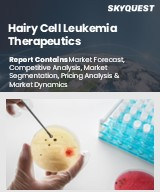
세계의 털세포 백혈병 치료 시장 규모는 2023년에 2억 6,000만 달러로 평가되며, 2024년에는 2억 8,000만 달러, 2032년에는 3억 9,000만 달러로 성장하며, 예측 기간(2025-2032년)의 CAGR은 4.29%로 성장할 전망입니다.
세계 유모세포백혈병 치료제 시장은 주로 건강한 조직을 보존하면서 악성 B세포를 효과적으로 표적하는 표적 면역요법의 발전으로 인해 크게 성장하고 있습니다. 이러한 기술 혁신으로 기존 화학요법을 넘어선 치료 옵션이 확대되고, 관해율이 향상되고 있습니다. 유세포분석 및 분자 프로파일링을 포함한 진단 방법의 강화는 조기 발견 및 맞춤형 치료 접근법을 촉진합니다. 의료 전문가와 환자 커뮤니티에서 인지도가 높아짐에 따라 첨단 치료법이 빠르게 도입되고 있습니다. 각 사들은 차세대 키나아제 억제제 및 모노클로널 항체 등으로 포트폴리오를 적극적으로 확장하고 있으며, 유효성 향상과 부작용 감소에 집중하고 있습니다. 유전체 프로파일링이 주도하는 맞춤형 의료의 흐름은 디지털 헬스 혁신과 협력적 노력과 함께 치료 프로토콜과 환자 치료 전략을 더욱 변화시키고 있습니다.
Global Hairy Cell Leukemia Therapeutics Market size was valued at USD 260 Million in 2023 poised to grow between USD 280 Million in 2024 to USD 390 Million by 2032, growing at a CAGR of 4.29% in the forecast period (2025-2032).
The global market for hairy cell leukemia therapeutics is experiencing significant growth, primarily due to advancements in targeted immunotherapies that effectively target malignant B-cells while preserving healthy tissue. These innovations have expanded treatment options beyond conventional chemotherapy, resulting in improved remission rates. Enhanced diagnostic methods, including flow cytometry and molecular profiling, facilitate early detection and tailored treatment approaches. Increased awareness among healthcare professionals and patient communities has led to the swift adoption of advanced therapeutic regimens. Companies are actively expanding their portfolios with next-generation kinase inhibitors and monoclonal antibodies, focusing on improved efficacy and reduced side effects. The trend towards personalized medicine, driven by genomic profiling, along with digital health innovations and collaborative efforts, is further revolutionizing treatment protocols and patient care strategies.
Top-down and bottom-up approaches were used to estimate and validate the size of the Global Hairy Cell Leukemia Therapeutics market and to estimate the size of various other dependent submarkets. The research methodology used to estimate the market size includes the following details: The key players in the market were identified through secondary research, and their market shares in the respective regions were determined through primary and secondary research. This entire procedure includes the study of the annual and financial reports of the top market players and extensive interviews for key insights from industry leaders such as CEOs, VPs, directors, and marketing executives. All percentage shares split, and breakdowns were determined using secondary sources and verified through Primary sources. All possible parameters that affect the markets covered in this research study have been accounted for, viewed in extensive detail, verified through primary research, and analyzed to get the final quantitative and qualitative data.
Global Hairy Cell Leukemia Therapeutics Market Segments Analysis
The global hairy cell leukemia therapeutics market is segmented based on treatment type, therapeutic approach, patient type, and region. In terms of treatment type, the market is divided into chemotherapy, radiation therapy, immunotherapy, targeted therapy, and stem cell transplant. Based on therapeutic approach, the market is trifurcated into single agent, combination, and maintenance. Based on patient type, the market is grouped into newly diagnosed, relapsed/refractory, and asymptomatic. Based on region, the market is segmented into North America, Europe, Asia-Pacific, Central & South America and the Middle East & Africa.
Driver of the Global Hairy Cell Leukemia Therapeutics Market
The global hairy cell leukemia therapeutics market is primarily propelled by the increasing adoption of targeted therapies and immunotherapeutics. These advanced treatment modalities specifically focus on malignant B-cells, significantly reducing the collateral damage to healthy cells, which ultimately enhances patient outcomes and minimizes side effects. Ongoing advancements in the development of monoclonal antibodies, kinase inhibitors, and bispecific constructs have broadened the spectrum of treatment alternatives available, particularly for individuals dealing with relapsed or refractory conditions. The introduction of novel therapies moving through late-stage trials and achieving regulatory approval is progressively influencing the established norms of frontline treatment.
Restraints in the Global Hairy Cell Leukemia Therapeutics Market
The market for hairy cell leukemia therapeutics faces significant challenges due to the rarity of the disease, which constrains the overall patient population. Many individuals, along with their primary care physicians, often do not easily recognize the symptoms associated with this condition, leading to delays in diagnosis and missed chances for timely treatment. This lack of awareness not only restricts the market's potential but also complicates the execution of large-scale clinical trials, particularly when new therapies are designed for targeted subpopulations. Consequently, these factors hinder market growth and the advancement of effective treatment options for affected patients.
Market Trends of the Global Hairy Cell Leukemia Therapeutics Market
The Global Hairy Cell Leukemia Therapeutics market is witnessing a notable trend towards the adoption of combination therapeutic strategies, where monoclonal antibodies are paired with kinase inhibitors or immunomodulators. This shift aims to address challenges such as drug resistance and the need for prolonged remission periods, particularly in patients with relapsed or refractory hairy cell leukemia. Clinicians are increasingly opting for combinations that ensure a balance between efficacy and tolerability, while ongoing clinical trials are investigating synergistic dosing schedules to optimize therapeutic responses. As precision medicine continues to evolve, these multi-agent approaches are redefining treatment sequencing and personalization in the market.